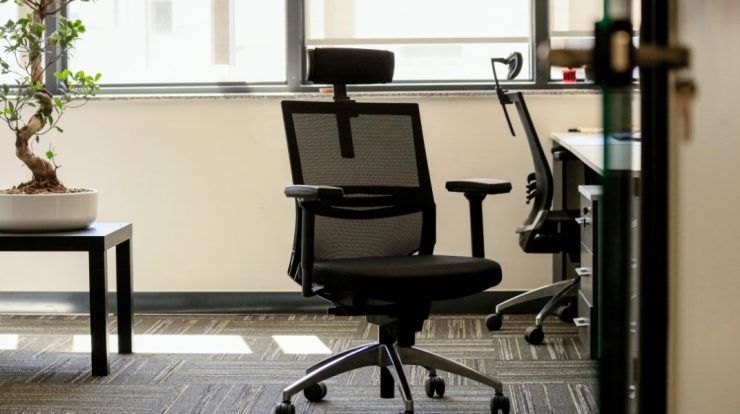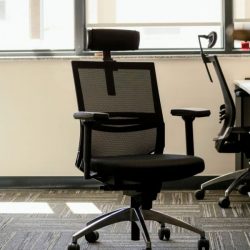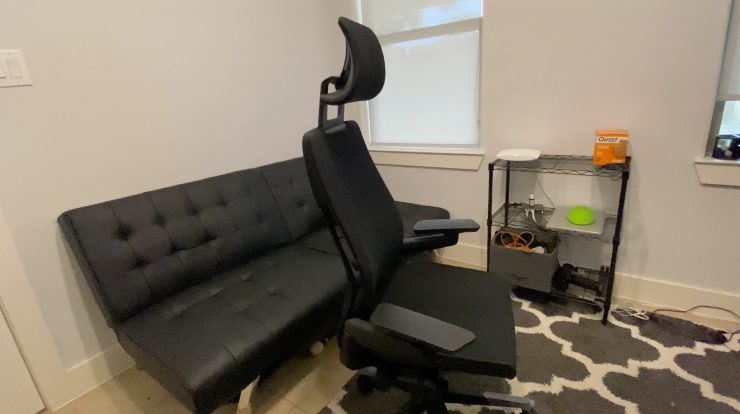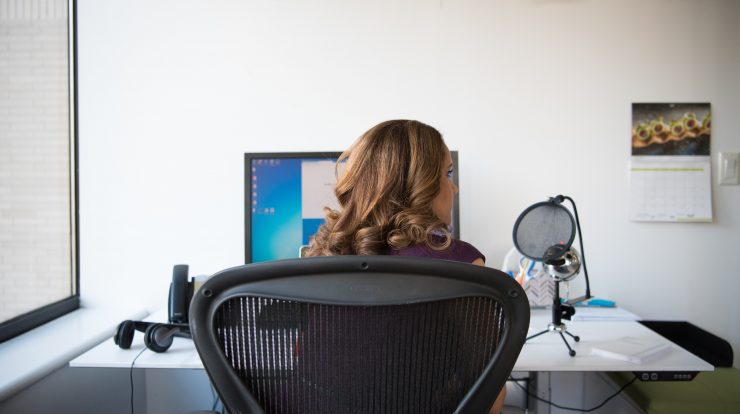
Sitting is the new smoking and who doesn’t know that!
Yet, we sit back to back for more than 10 hours a day because we don’t have a choice (well, that’s what we assume).
Sitting was supposed to be a relaxing activity a few decades ago. But, somewhere down the line, we lost the balance between sitting and standing (and probably exercising).
Technological advancement reduced the amount of physical work that we had to do a few years ago. Even though we used to spend more than 10 hours in the office, we still used to sit far less than what we do these days.
No wonder why millions of people across the globe suffer from lower back pain from sitting too long despite having access to ergonomic office furniture.
This post contatins affliliate links. If you click on one of these links and then make a purchase from the linked advertiser, I’ll make a commission at no extra cost to you. Click Here to read my Privacy Policy and Affiliate Disclosure.
Having the best office chair for back pain is not enough
Ergonomic furniture, specifically ergonomic chairs with lumbar support alleviates back pain, improves posture, prevents hunching and neck strain, promotes a healthy posture, and increases the overall work efficiency. But, they are still not enough to counter the side effects of back to back sitting.
The same is the case with exercising 30 minutes a day. You need much more than that to deal with the ‘new form of smoking’.
Of course, you can’t quit being in your office for more than 8 hours! But, you can definitely be more active while at work.
That’s what this article is all about. Here, we will suggest some of the best ways to deal with lower back pain from sitting too long without compromising the quality and quantity of your work. The methods that we are going to suggest here may require some investment but they are worth it. Rather, they are cheaper than the fees of your chiropractor and better than taking painkillers or muscle relaxants.
Our suggestions are not only beneficial for people suffering from back pain from sitting but also for people dealing with obesity, cardiac problems, irregular blood pressure, musculoskeletal problems, stress and anxiety, and numerous other issues.
Before we begin, let’s ensure that:
- You are using an ergonomically designed office chair for lower back pain. If not, then here are some of the best options that we recommend. We have also recently reviewed the Steelcase Gesture chair and we highly recommend it to anyone who can spend $1000 for an office chair. Read its full review here.
- You exercise for at least 30 minutes a day, 5 times a week.
- You do at least 7 to 10 minutes of basic stretching specifically targeting your neck, spine, buttock, and hamstring muscles because they are the ones that suffer the most due to excessive sitting. If you are not that, this video will help you.
1. Create a sit-stand workstation
The standing desks are basically height-adjustable desks. They usually have a lever that lets you adjust their height smoothly without applying any force. You can adjust the height even when you have two monitors, a laptop, a printer, and numerous other things randomly placed on your desk. And, you can adjust them multiple times a day without worrying about the mechanism failing any time soon.
Sounds amazing, isn’t it?
They are a boon for people who have been struggling with obesity, heart diseases, and chronic back pain due to sitting in a chair for prolonged periods.
Standing desks help:
- Burn more calories
- Maintain a healthy blood sugar level
- Lower the risk of heart diseases
- Significantly alleviate the symptoms of chronic back pain
- Improve blood flow
- Reduce anxiety and stress
- Boost productivity
By changing your positions regularly from sitting to standing and vice versa, you will be able to ditch your sedentary work practices, which eventually take a toll on your spine, neck, and overall health. You will feel more active and energetic.
If you are willing to invest in a sit-stand office desk, here are some of the best-rated products that we highly recommend.
While using a standing desk, please make sure you buy an anti-fatigue desk mat too because standing on a hard surface can be uncomfortable and even painful. Check out this article that lists some of the best-rated standing desk mats.
2. Use an under desk treadmill
Standing is good; walking is better!
Under desk treadmills are very basic equipment with foldable arms or no arms at all. You can slide them under your height adjustable standing desk and, instead of sitting back to back, you can just get up, remove your chair, slide the treadmill, and walk slowly.
You can jog too but under desk treadmills are not meant for serious sessions of jogging or running. Plus, they do not have arms that you can hold on for support, just in case you slip off. So, if you run on them, the chances of injuries are comparatively high. Moreover, running is exhausting and can distract you.
The idea of using the under desk treadmill is to make you feel more active, reduce pressure on the body, and increase productivity. It shouldn’t be an exhausting task. Stick to walking and that will do enough to help you deal with the lower back pain while sitting.
This article lists some of the best-rated under desk treadmills that you can use in your home office.
Under desk treadmills cannot replace your regular exercise
They are only meant for slow, casual walks during working hours. They cannot compensate for the 30 minutes of exercise that you need to do at least 5 days a week. So, even if you spend 2 hours on your under desk treadmill, you will still have to stick to your workout routine religiously.
Wear well-cushioned shoes to stay comfortable
Heels, dress sandals, flip-flops, etc. increase the amount of pressure we put on our feet. They can throw off our balance and, instead of alleviating back pain while sitting, they can worsen it.
You must, therefore, use well-cushioned shoes, preferably walking or running shoes.
While using an under desk treadmill, take your time to get started with it. Do not start using it for long hours from day one. Try it for 15 minutes twice a day and gradually increase the time and frequency.
3. Use an under desk elliptical
Under desk ellipticals were originally designed for small homes and for people with limited mobility who can’t use a full-sized elliptical. Soon, people started realizing that they can be used in home offices too! They may not directly address the issue of lower back pain from sitting too long. But, they can still help you deal with numerous other side effects of excessive sitting.
The main selling point of under desk ellipticals is that they do not distract you. The only thing that moves is your legs and that too very smoothly! They are inexpensive, compact, and lightweight. So you can move them around or just keep them in a corner of your office. Another reason why people love them is that they are easy on joints. So, if you can’t stand or walk, you can still do something to beat the inactivity in your work.
We love the products listed in this article. These options are enough to serve your purpose.
Honestly, mini ellipticals are not as effective as standing ellipticals but they can provide you with some extra movements and help your muscles stay active and engaged.
4. Take frequent breaks from sitting
You can hate us for saying this. But, that’s one of the proven ways to relieve back pain due to excessive sitting.
It’s not as difficult or distracting as we think it is. Your computer can keep you hooked for hours and hours but you have to choose whether you want to stay hooked and end up with chronic back pain or you want to be healthy, happy, energetic, and productive (and social too!).
Here is what you can do to ensure that you take ample walking breaks:
Set inactivity alerts
The latest smartwatches have inactivity alerts that can warn you if you have been sitting for far too long. If you don’t have them, you can simply set a timer on your phone or watch. You can also use any of the dozens of apps that alert you if you haven’t walked for a while. Configure them to alert you every 30-45 minutes, so you get prompted to take a break.
Do a light workout
You don’t have to necessarily stroll around your office corridor during your breaks. You can quickly grab a loop band or resistance band and do some squats or standing leg raises. If you have some space in your office, you can get that converted into an activity center, so people can exercise there whenever needed. You can spread an exercise mat and do some stretches or maybe do a quick set of pushups. Anything and everything is fine as long as it gets you moving.
Yes, others will judge you initially but, soon, they too will join the league because who doesn’t want to be healthy!
Get up for lunch and coffee breaks
Skipping meal breaks can do more harm to your body (and mind) than you could possibly imagine. Yes, you had your lunch while sitting but you missed out on the opportunity to get up from your desk, walk around, talk to your coworkers or family members, and most importantly, give a break to your body, especially your eyes, shoulders, and your back.
No matter how overworked you are, we strongly recommend that you must take your meal breaks and coffee breaks sincerely. If you are taking a coffee break, we highly recommend that you stand in the corridor or in a corner of the cafeteria along with your colleagues instead of sitting.
Stay hydrated
Did you know more than 70% of people do not drink enough water at work?
Wondering what it has to do with back pain due to excessive sitting?
Well, you will be surprised to know that dehydration can cause your spinal disc to lose water, which can reduce the cushioning between the spinal bones. This will ultimately make you suffer from chronic back pain. Even the best office chair for back pain will not be able to help you in that case.
Make sure you drink a glass of water every 30 minutes even if you aren’t thirsty. Always use a small cup or small bottle to store water at your desk. Smaller bottles will force you to get up for a refill more often.
And don’t worry about taking too many restroom breaks. You need them to stay active!
5. Encourage walking interactions and meeting
If Steve Jobs and Mark Zuckerberg can hold walking meetings why not you?
Encourage your colleagues to leave their desks and meet you in the corridor of any other area of your office where you can walk and talk without being disturbed. Walking meetings work the best when they are held between small groups. So, do not invite people who aren’t really necessary for the meeting. Also, do not order a white chocolate mocha. That way, you will be able to reduce your calorie intake too!
Worried if walking meetings will be effective?
Why not try it out a few times?
Studies have proven that when you get up from your desk, move to a place where you can get plenty of natural light, and look at the nature around you, your neuro-pathways will clear up and help you think better. It also adds fun to the otherwise boring meetings held in boardrooms or cabins.
If you are working from home, you can mount your phone on a gimbal and hold your video meetings while strolling in your lawn! Hohem 3-Axis Gimbal Stabilizer for Smartphone is especially meant for that. Don’t you think it will help you get rid of the lower back pain from sitting too long?
6. Utilize every opportunity to be active
There are endless possible ways to be more active while at work. Here are a few things that we usually do and they have helped us a lot:
- Instead of calling or texting a coworker who sits just a short walk away, you should go to his/her desk instead. Encourage others to do that too!
- Go to the farthest restroom to get a longer stroll.
- Stand up and walk around while answering a phone call. Maybe march in place!
- While reading emails, stretch your neck and spine. Watch the video above to see some of the basic stretches you can do while sitting on your office chair.
- Change your office wardrobe. Throw away those skirts, tight-fitting trousers, heels, etc. because they are literally killing you! Opt for loose clothings and well-cushioned shoes, so you can be more comfortable and active at work.
7. Practice proper sitting posture
Image source: Ergonomic trends
The above image clearly illustrates the amount of pressure that your spine bears when you sit in a wrong position.
Even though you have an ergonomic chair, there are high chances that you could still be sitting in an incorrect posture. Here are a few things that you need to do to deal with the back pain from sitting for extended hours.
- Ensure that your back is not hunched and your shoulders are pulled back. Your buttocks should touch the end of your seat. Your back should rest against the backrest of your chair.
- The backrest of your chair should be reclined to 100/110 degrees, as recommended in the image above.
- Make sure you have your feet evenly rested on the floor. You can use a footrest if needed.
- Do not let the back of your knees touch the edge of your seat. Have at least 2-3 inches of gap to reduce the pressure buildup on the underside of your thighs.
- Never sit cross-legged, as it restricts blood flow
- Position your monitor so that the screen is right at eye level. If required, mount your monitor on a height-adjustable stand such as the Huanuo 17-32” Monitor Mount Stand.
- Keep your neck upright. Even a 15 degree of forward tilt can double the pressure on it.
- If you are into a profession that requires excessive usage of a mouse, try replacing your standard mouse with a vertical one like the Logitech MX Vertical Wireless Mouse. Add the Bitpro LGM Gaming Mousepad underneath to provide cushioning to your wrist.
Watch the video below for more details:
Wrap up
The above suggestions might sound too much but you don’t have to do all of them every day and every time. Plus, you don’t have to start all of them together. Go slow and get into the habit of being active. Encourage everyone in your team or office or home to do that so you won’t feel odd.
Please note that this article is not medical advice for lower back pain from sitting too long. Here, we are only suggesting some non-medical approaches to prevent back pain and neck strain. If you are suffering from chronic pain, make sure you consult a doctor. Also, if you need help in creating an ergonomic workstation, seek help from your chiropractor.



